List of pear cultivars
Over 3000 cultivars of the pear are known.[1] The following is a list of the more common and important cultivars, with the year and place of origin (where documented) and an indication of whether the pears are for cooking, eating, or making perry. Those varieties marked agm have gained the Royal Horticultural Society's Award of Garden Merit.
Table of pears
- 'Abate Fetel' (syn. Abbé Fetel; a major cultivar in Italy)[2]
- 'Alexander Lucas'
- 'Ambrosia'
- 'Ayers' (United States – an interspecific P. communis × P. pyrifolia hybrid from the University of Tennessee)}
- 'Bambinella' (Malta)
- 'Bartlett' (United States name for Williams' bon chrétien)
- 'Black Worcester' (England – a cooking pear that keeps well)
- 'Blake's Pride' (United States)
- 'Blanquilla' (or 'pera de agua' and 'blanquilla de Aranjuez', Spain)
- 'Bon Rouge'
- 'Bosc'
- 'Beurre Hardy'
- 'Butirra Precoce Morettini'
- 'Carmen'[3]
- 'Cascade'
- 'Catillac'
- 'Churchland'
- 'Clairgeau'
- 'Clapp's Favourite'
- 'Clara Frijs' (major cultivar in Denmark)
- 'Concorde' (England – a seedling of 'Conference' × 'Doyenné du Comice)
- 'Conference' (England, 1894)
- 'Corella' (Australia)
- 'Coscia' (very early maturing cultivar from Italy)
- 'Claude Blanchet'
- 'D'Anjou'
- 'Dessertnaja'
- 'Don Guindo' (Spain – strong yellow, flavoured taste)
- 'Doyenné du Comice' (France)
- 'Dr. Jules Guyot'
- 'Earlibrite'
- 'Elektra'
- 'European' (Pyrus communis)
- 'Flemish Beauty' (also called 'Fondante des Bois')
- 'Forelle'
- 'General Leclerc'
- 'Gerburg'
- 'Giffard'
- 'Glou Morceau' (Belgium, 1750)
- 'Gorham' (United States)
- 'Harobig'
- 'Harovin Sundown'
- 'Harrow Crisp'
- 'Harrow Delight' (Canada)
- 'Harrow Gold'
- 'Harrow Red'
- 'Harrow Sweet' (Canada)
- 'Harvest Queen'
- 'Hermann'
- 'Hortensia'
- 'Huntington Pear'
- 'Isolda'
- 'Joséphine de Malines' (Belgium – obtained by Esperen, pomologist and mayor of Malines in the 19th century; one of the best late season pears)
- 'Kieffer' (United States – a hybrid of the Chinese "sand pear", P. pyrifolia and probably 'Bartlett')
- 'La France' (France)
- 'Lategale'
- 'Laxton's Superb' (England; no longer used due to high susceptibility to fireblight)
- 'Le Conte'
- 'Louise Bonne' (France)
- 'Luscious' (United States)
- 'Merton Pride' (England, 1941)
- 'Moonglow'
- 'Nashi' (Pyrus pyrifolia, Asian/Japanese/Chinese/Korean/Taiwanese/sand pear)
- 'Onward'
- 'Orcas'
- 'Orient' (United States – an interspecific P. communis × P. pyrifolia hybrid)
- 'Packham' (short for 'Packham's Triumph', Australia, 1896)
- 'Parsonage'
- 'Pineapple' (United States – an interspecific P. communis × P. pyrifolia hybrid)
- 'Red Bartlett' (United States name for Williams' bon chrétien – There are three major red-skinned mutant clones: 'Max Red Bartlett', 'Sensation Red Bartlett', 'Rosired Bartlett')
- 'Rocha' (Portugal)
- 'Rosemarie' (South Africa)
- 'Seckel' (United States; late 17th century Philadelphia area; still produced, naturally resistant to fireblight)[10]
- 'Starkrimson', also called Red Clapp's, is a red-skinned 1939 Michigan bud mutation of Clapp's Favourite. Its thick, smooth skin is a uniform, bright and intense red, and its creamy flesh is sweet and aromatic.[11]
- 'Stinking Bishop'
- 'Summer Beauty'
- 'Summercrisp'
- 'Sudduth'
- 'Taylor's Gold' (New Zealand – a russeted mutant clone of 'Comice')
- 'Tosca'
- 'Turandot'
- 'Uta'
- 'Vicar of Winkfield' (England – a green skinned cooking pear)
- 'Virgouleuse'
- 'Williams' (short for Williams' bon chrétien)
- 'Winter Nelis'
Cider pears
Cider pears (Perry pears) may be far too sour or bitter for fresh eating, but are used for making cider. Some pears (especially older ones from the U.S. and Canada) are used for both cider and eating purposes.
| Common name | Image | Origin | First developed | Comment | Use |
|---|---|---|---|---|---|
| Kosui (幸水) |  |
National Institute of Fruit Tree Science, Japan | c. 1959 | Russet apple pear (Pyrus pyrifolia subsp. culta) | Cider, cooking, eating |
| Hosui (豊水) | National Institute of Fruit Tree Science, Japan | c. 1972 | Russet apple pear (Pyrus pyrifolia subsp. culta) | Cider, cooking, eating | |
| Nijisseiki (二十世紀) | 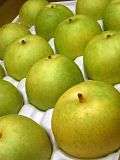 |
Matsudo, Chiba, Japan | c. 1888 | Green apple pear (Pyrus pyrifolia subsp. culta) | Cider, cooking, eating |
Gallery
 Anjou
Anjou_-_Beurre_Bosc.jpg) Bosc
Bosc Conference
Conference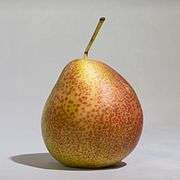 Forelle
Forelle European Pear
European Pear Le Conte
Le Conte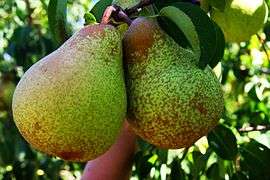 Pêra Rocha
Pêra Rocha- Pyrus pyrifolia
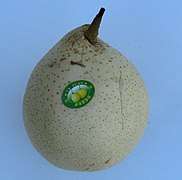 Pyrus bretschneideri
Pyrus bretschneideri Warden
Warden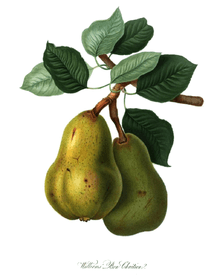 Williams (Bartlett)
Williams (Bartlett)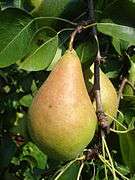 Vicar of Winkfield cultivar
Vicar of Winkfield cultivar
References
- ↑ Elzebroek, A.T.G.; Wind, K. (2008). Guide to Cultivated Plants. Wallingford: CAB International. p. 27. ISBN 1-84593-356-7.
- ↑ Predieri, Stefano; Gatti, Edoardo (2009). "Effects of cold storage and shelf-life on sensory quality and consumer acceptance of 'Abate Fetel' pears". Postharvest Biology and Technology. 51: 342–8.
- ↑ "Pero – in Italian" (PDF).
- ↑ "ニホンナシ育成品種の系統図 :果樹研". Archived from the original on 2011-10-03.
- ↑ NSW Primary Industries 2002. Nashi asian pear varieties, kosui. Agfact H4.1.14
- ↑ "ニホンナシ育成品種の系統図 :果樹研". Archived from the original on 2011-10-03.
- ↑ NSW Primary Industries 2002. Nashi asian pear varieties, housui. Agfact H4.1.14
- ↑ "ニホンナシ育成品種の系統図 :果樹研". Archived from the original on 2011-10-03.
- ↑ NSW Primary Industries 2002. Nashi asian pear varieties, nijiseiki. Agfact H4.1.14
- ↑ U.S. Department of Agriculture. (September 2004.) "Pyrus Crop Germplasm Committee: Report and genetic vulnerability statement, September 2004". (Website.) Germ Resources Information Network (GRIN), pages 5-7, 10. Retrieved on 2007-10-02.
- ↑ Dris, Ramdane, and S. Mohan Jain (editors.) (2004.) "Production Practices and Quality Assessment of Food Crops: Volume 3, Quality Handling and Evaluation". Springer, page 274, ISBN 978-1-4020-1700-1. Retrieved on 2007-10-10
This article is issued from
Wikipedia.
The text is licensed under Creative Commons - Attribution - Sharealike.
Additional terms may apply for the media files.